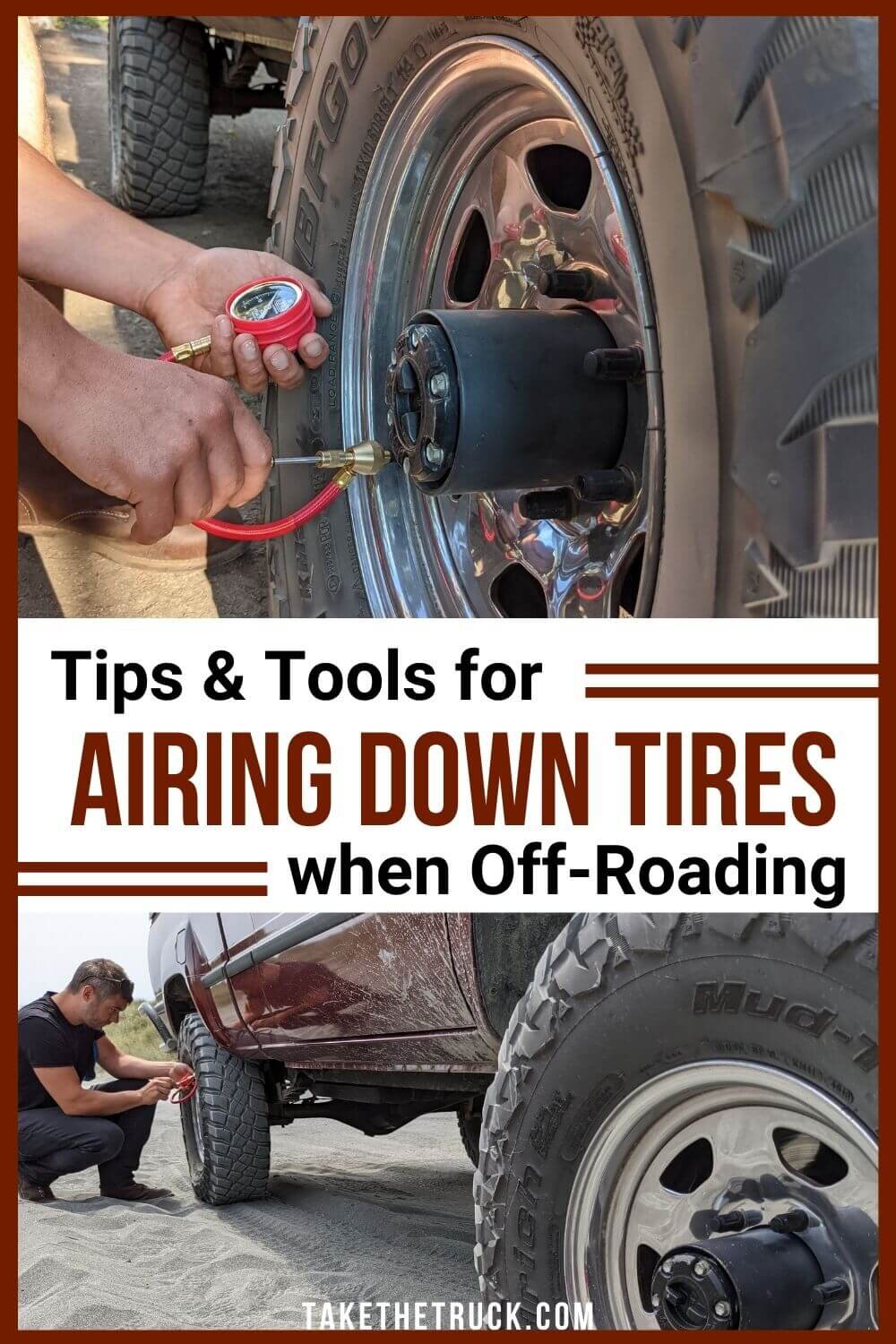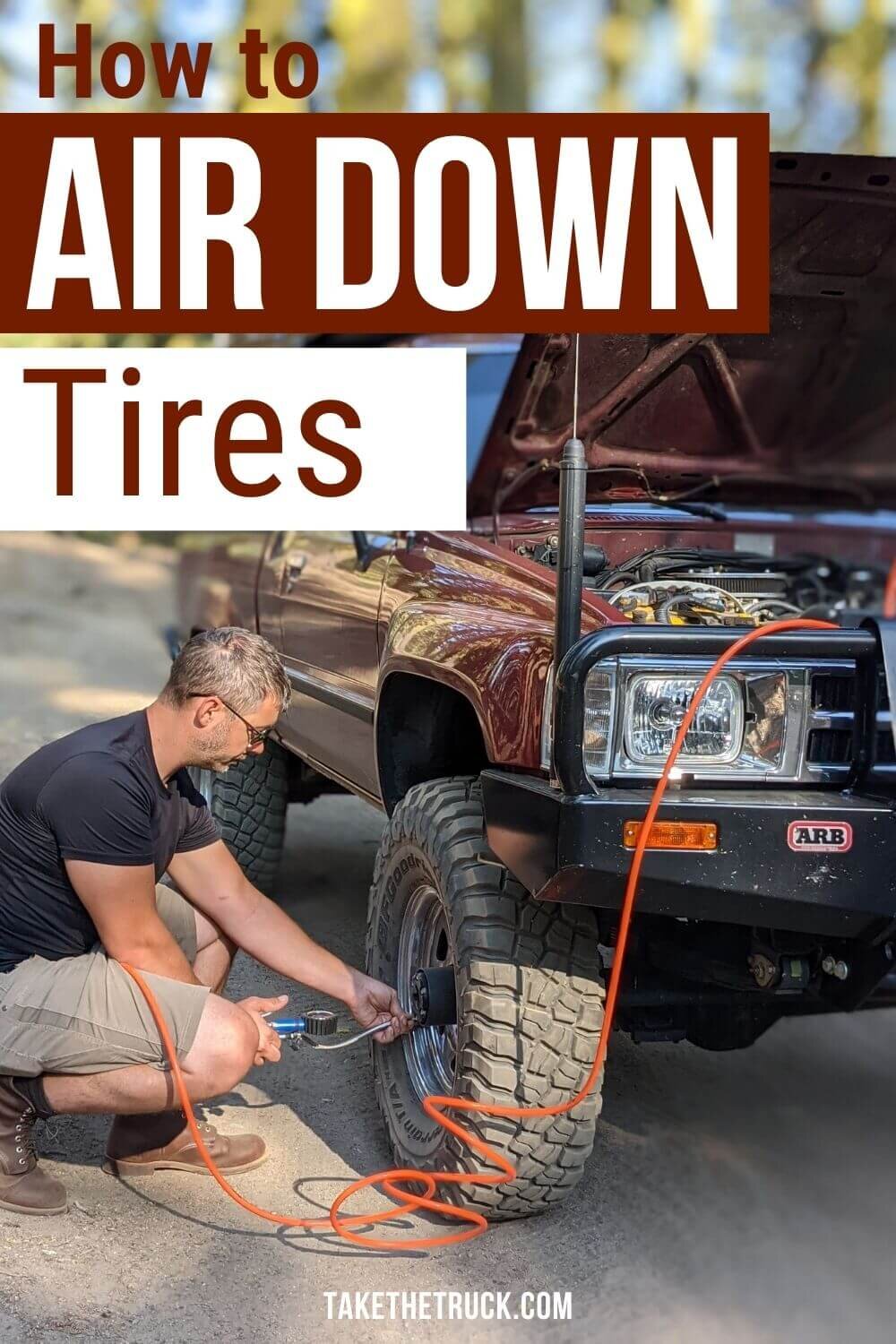How to Air Down Tires for Off-Road Driving and Overlanding
Airing down your tires - or letting air out of each tire to reduce the amount of pressure inside - is one of the single best improvements you can make to your vehicle’s off-road driving performance. And unlike many off-road or overlanding modifications, it doesn’t have to cost anything!
The Benefits of Airing Down Your Tires
There are several benefits of airing down when on an overlanding or off road adventure, but the three main ones are:
Increased traction off road
Improved ride comfort on rough terrain
Reduced likelihood of tire damage or excessive wear
When Should You Air Down, and How Much
While there’s no universal guideline on when airing down will be beneficial or what exact pressure you should air down to, there are some general rules of thumb:
General off-road driving on rough dirt roads, two-track, and mild trails - a 25% reduction or 10 PSI is a good place to start
Traversing slickrock or more challenging trails with loose terrain, a 30-35% pressure reduction may be in order
Very soft terrain conditions such as sand or mud may benefit from up to a 50% pressure reduction
While lighter vehicles can typically run lower tire air pressure off-road as compared to larger heavier overland vehicles, choosing how much air to let out of your tires will ultimately depend on a variety of factors including: your specific overland vehicle’s characteristics, the weight it’s carrying, tire selection, what on-road pressure you typically run in your tires, and your own preferences and comfort level.
*(This post contains affiliate links. This means we may receive a small commission, at no additional cost to you, if you make a purchase through a link. See our full disclosure.)
What You’ll Need to Air Down
One of the great things about airing down is that you don’t need much equipment to be able to do it - though there are some tools that can make it much easier.
Start by selecting a good set of Overlanding Tires for your rig - a quality off road tire performs significantly better when airing down
An accurate tire pressure gauge (preferably with a dial indicator)
A device for letting air out of your tires (discussed in detail below)
And a means to air your tires back up (also discussed below!)
**We always recommend carrying a good tire repair kit* as well, just in case
Methods for Airing Down Tires
When it comes to airing down your tires, there are 4 basic methods that can get the job done depending on what your budget is:
1. Manually Airing Down
This is the simplest and cheapest method for airing down your tires.
All you need is a tire pressure gauge. If you’re using the typical basic sliding tire gauge*, you can use the nodule on the back to depress the schrader valve at the end of the tire stem and allow air to escape - pausing regularly to recheck pressure, and being careful not to go under your target tire pressure.
Another manual method that's a little easier is to use a tire pressure gauge with a dial* that attaches directly to the valve stem, and has a button that allows pressure to be released. Pause regularly and release the button to allow the gauge to display the current air pressure in the tire.
Manually airing down with these methods is time consuming - taking an average of 4-6 minutes per tire to release enough air to hit your target tire pressure. So if you’re usually in a hurry to hit the trail you may want to consider investing in a dedicated Tire Deflation Tool.
2. Tire Deflation Tools
A tire deflation tool, like the ARB E-Z Deflator*, makes the process of airing down off road much faster.
The tire deflation tool physically removes the valve core - the mechanism in the schrader valve that prevents air from escaping - storing it internally to keep it free from dirt and allowing air to freely escape through the valve stem.
Just be sure to stop air flow frequently to monitor the gauge, and stop once your desired pressure is met.
3. Automatic Tire Deflators
Automatic tire deflators, like these high-quality Staun Tyre Deflators, are the easiest method for airing down tires.
They can be adjusted to a pre-set PSI, attached directly to the schrader valves on each tire, and then you simply pull the pin and the automatic tire deflator will air down the tires to the preset pressure and stop once that pressure is met.
Though they are a bit pricey, they take up far less space than most other airing down tools.
4. Combination Tire Inflator/Deflator
The Indiflate 2 Hose Inflator/Deflator* is a slightly faster and more versatile tire deflation tool allowing you to deflate two tires simultaneously. And when paired with a compressed air source it will also inflate two tires at the same time to equal pressures.
Convenience comes at a cost, though, and it is quite a bit more pricey than other airing down options.
Methods for Airing Back Up
There are a variety of ways to return your tires to normal operating pressure once you’ve aired down, had some fun off-road, and are ready to return to pavement.
1. Use Someone Else’s Compressor
If you only occasionally drive off-road, one of the cheapest methods for airing up your tires after coming off the trail is to simply go to a nearby gas station or car wash that offers compressed air and use their compressor to air back up.
OR if you’re traveling with a friend who has an air compressor on their overland rig, borrow theirs!
The downside is that you can’t always count on the easy access to, or availability of, a compressor to borrow near a trail. And prolonged driving on pavement with under-inflated tires can be dangerous and detrimental to your tires longevity, so plan accordingly before heading out.
2. Portable Air Compressors
If you plan to go overlanding or off-roading on a regular basis, but don’t want the hassle of wiring and installing an permanent on-board air system in your vehicle (more on this below), a quality portable air compressor may be the best solution for reinflating your tires if you’ll be airing down on a regular basis.
**When comparing air compressors, note that the “duty cycle” of an air compressor represents the amount of time the compressor can operate in a given time-frame at 100PSI and 72°F. For example a 33% duty cycle means that in one hour the compressor can operate for 20 minutes on, and needs 40 minutes off while a compressor with a 100% duty cycle can operate continuously for all 60 minutes.**
Portable air compressors come in a convenient kit and can be simply attached to your vehicle’s starting battery with the supplied clamps, allowing you to air up quickly and easily. Below are three solid choices at various price points depending on your usage needs:
Budget Portable Compressor
Viair 300P Portable Compressor - 33% duty cycle, more than capable of handling most tire inflation needs, but the limited duty cycle will make it a slower process
Mid-Range Portable Compressor
ARB CKMP12 Portable Compressor - 50% duty cycle, great for airing up, and for limited air tool use off road (such as running an air powered impact wrench for removing wheel lugs)
3. On-board Air Compressors
On-board Air Compressors are hardwired into your vehicle's electrical system and controlled with a switch inside your vehicle. They allow a faster and more convenient access to compressed air for returning your tires to street pressure after airing down.
They can also be used to operate air-locking differentials if you happen to upgrade your 4x4 vehicle to ARB Airlockers down the road to improve off-road performance.
Budget On-board Air Compressor Kit
ARB CKMP12 Compressor Kit - 50% duty cycle, great for airing up and light air tool usage (especially when paired with the optional 1 gallon air tank*)
High-End On-board Air Compressor Kit
ARB CKMTA12 Twin High Performance Kit - 100% duty cycle, excellent for airing up tires and capable of handling fairly heavy air tool usage while off road
4. CO2 Tank Based Off-road Tire Inflation Systems
Compressed carbon dioxide tank based systems, like the one pictured below, can be used to air up your tires much more rapidly than other methods.
They have no electrical components and far fewer mechanical components to wear or potentially break, meaning you’re less likely to ever get stuck without a way of airing back up.
A 10lb CO2 tank holds the equivalent of nearly 400 gallons of compressed air.This is enough to air up a 33in off-road tire by 20 PSI approximately 30 times! The CO2 tank does, however, eventually need to be filled again (requiring recurring expense), and they are somewhat pricey to begin with.
We hope this guide has helped you understand how airing down can improve your next overland adventure, as well as helped you choose a method for airing down that matches your needs and budget.
For more helpful overlanding, truck camping, and family travel info be sure to SUBSCRIBE for our blog updates.
And as always, thanks for reading!
Related Posts:
Pin This Post!
We’d Appreciate a Share! Thanks!













